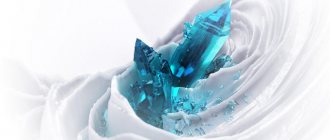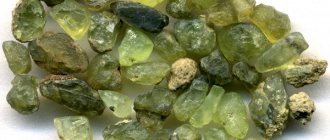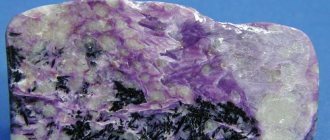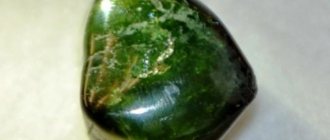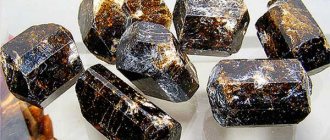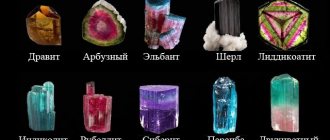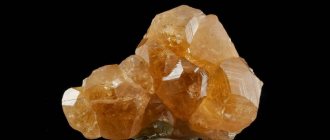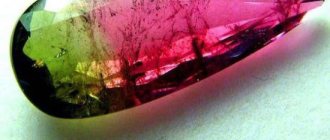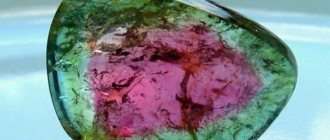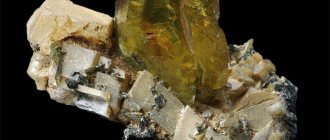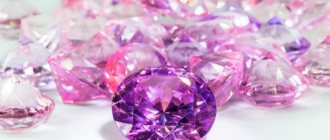And when you really, really dream and do something about it, the dream always comes true. In 1987, he found a mineral of amazing beauty, but, unfortunately, the seeker himself did not see the triumph of the found jewel; by this time he was seriously ill. And the stone was named after the Brazilian state - Paraiba.
What is so fascinating about the Paraiba stone?
Paraiba is a tourmaline with a unique color.
Tourmaline itself has been known for a long time. Its color diversity is due to the presence of up to 50 different elements. Possessing the same crystal structure, tourmaline can undergo various changes, since its chemical composition is complex. Mohs hardness: 7.5;
density: 3.2 g/cm3. Until the Paraiba stone was discovered, it seemed that tourmaline already possessed all the colors of the rainbow. It turns out that his color palette was missing a turquoise crystal.
The Paraiba color is simply stunning. It is impossible to take your eyes off it, its radiance is mesmerizing. It sparkles even in the dark, and in daylight it blinds. The splendor of color is unique, Paraiba excites the imagination.
Paraiba can range from a deep blue neon color to a greenish neon color. The crystals of this gemstone contain copper, manganese, magnesium, and therefore there are turquoise, emerald green, sky blue, violet and even purple Paraibas. But Paraiba stone is valued precisely for its turquoise hue, which the presence of copper gives it.
At the same time, the Paraiba stone is the only one of all precious stones that contains traces of gold.
Paraiba is a tourmaline, but why, among the many multi-colored tourmalines, did this particular crystal receive a separate name? The secret is all in the neon light of the stone. Not a single photograph of a stone can convey this miracle of nature. And this light of the stone is already visible in the uncut crystal. But if the stone has been in the hands of a master jeweler and received a cut, then its radiance becomes even stronger, or, more simply, it burns with some kind of internal fire.
Often, when talking about its unique radiance, they use the words neon or electric. Rays of light, penetrating through the crystal, are scattered without visible weakening, the gem even enhances them, creating a neon glow. And the space around the paraiba is illuminated with a soft blue glow, like a glowing light bulb. The peculiarity lies in the amazing glow of this stone, which shines even at dusk.
Paraiba deposits
As already mentioned, the first deposit was Brazil. Today there are several other places on the planet where these stones are mined. These are Madagascar and Mozambique. The stones of Brazil are considered to be the best in quality.
After the first discovery, this stone began to quickly disappear along with the hills under which a seeker named Heitor Diaz Barbosa found them. But over time, high-quality paraiba was discovered in another state of Brazil - in Rio Grande do Norte.
Paraiba was recently found in Nigeria. According to scientists, about 100 million years ago there was a fault that divided the land, forming South America and Africa. Therefore, this unique mineral is found in western Africa and eastern South America.
History and origin
The first deposits of a new variety of tourmaline were discovered by a Brazilian miner in a state called Paraiba. Finding a mine with precious minerals became the goal of Heitor Barbosa's life. The miner carefully explored the abandoned deposits, and in 1986 the search ended in success. A lucky miner finally found an unknown transparent mineral of a bright blue color with an unusual inner glow.
Mineral – Paraiba
Unfortunately, the new deposit turned out to be negligible; reserves were exhausted after just a week of active development. The joy of the discovery undermined the health of the discoverer, and Barbosa soon died, never having seen the sensation created by the luminous tourmaline.
A little later, the Paraiba deposit was found in the Brazilian state of Rio Grande Do Norte.
Until 2001, the mining of Paraiba was not mentioned, until a new deposit of a unique mineral was discovered in Nigeria. Although African stones were inferior in purity to Brazilian gems, they still quickly found recognition among jewelry connoisseurs.
Interesting! Already in 1990, the heavenly-colored mineral with an internal glow was compared in value to diamonds and awarded the highest rating at a jewelry exhibition held in one of the American states.
Geological puzzle
Geologists believe that the coincidence of the structure, composition and color of African and Brazilian Paraiba tourmalines is not an accident. These stones were formed under the same conditions; their deposits were once located nearby, on the proto-continent Pangea, which 150 million years ago split into smaller continents known to us today. So some of the deposits remained in South America, and some “sailed” overseas along with Africa and Madagascar due to continental drift.
World map
Take a look at the world map. The outlines of the western coast of Africa, like an element of a puzzle, fit the outlines of the opposite coast of the Atlantic - the eastern coast of South America. And the Brazilian state of Paraiba sits on a ledge that would complete this geological puzzle, perfectly filling the Gulf of Guinea. This is where Guinea is located.
And the island of Madagascar follows the coastline of continental Mozambique. It turns out that they were once one.
Visual animation of continental drift:
The movement of lithospheric plates that carry the Earth's continents is confirmed not only by geology, but also by paleontology. On now widely separated puzzle coasts, scientists have discovered the remains of the same dinosaur species. Land lizards couldn't swim across the ocean, could they?
Physical properties
| Property | Description |
| Hardness on the Mohs mineral hardness scale | 7,5 |
| Density, | 3.0 cm³ |
| Specific gravity | 2.84-3.10 (average 3.05) |
| Kink | Uneven, conchoidal |
| singonia | Trigonal |
| Fragility | High |
| Shine | From glassy to smoky |
| Transparency | Transparent |
| Color | Neon blue, chartreuse blue, teal green, mint green, rare purple and purple |
The uniqueness of the mineral lies in its color shades, which change depending on the lighting. The natural color of the gem is bright turquoise with a sky blue or greenish tint. When exposed to light, the stone glows from within, creating a bright blue halo around itself. For internal glow, the gem does not need sunlight; the stone can glow even in twilight conditions.
Important! Paraiba, mined in Brazil, is the only precious mineral on the planet that does not cast a shadow when exposed to sunlight.
Spark Creations
New York jewelry house Spark Creations managed to present the classic combination of colors - blue and white - in a very elegant and graceful form. The delicate triangular pendant features a vibrant 5-carat Mozambican tourmaline surrounded by shimmering pavé diamonds. The metal chosen is 18-karat white gold. The cost of the decoration is $85,375.
Advertising - Continued below
Types of stone
After the discovery of African deposits, luminous tourmaline was divided into subgroups.
Also read: Melanite - a type of garnet
The most valuable and pure stones are considered to be gems from Brazilian mines. These minerals are in demand in jewelry production and are valued at the highest category. The price for 1 carat of such a stone reaches 20 thousand US dollars.
Gems mined in African deposits were given the name Paraiba Type, which literally means “Paraiba Type”. To ensure blue tourmaline matches the Brazilian gem, African jewelers apply high temperatures to the stones. After this treatment, the mineral acquires a natural turquoise hue characteristic of Paraiba, but the internal glow of the stone disappears.
Reference! Modern technologies make it possible to create analogues of the Brazilian gem from various varieties of tourmaline. Most often, purple or green crystals are used to make fakes.
Sitall, a nano-relative of Swarovski
Among young people who prefer budget jewelry to unaffordable gems, there is considerable demand for excellent imitations of precious stones made from artificial material under the trade name glass ceramic . This is quartz glass, welded in a special way with tiny crystals of natural rocks and microscopic metal flakes. This is roughly how Swarovski rhinestones are created.
These inclusions are so small that jewelry glass ceramic is often called nanosynthetics.
Indeed, the internal structure of artificial stone consists of nanostructures measured in millionths of a meter (nanometers).
Medicinal properties
Natural gems have been resting in the depths of the earth for thousands of years, accumulating energy within themselves. Therefore, natural minerals are used in both official and folk medicine. Since ancient times, with the help of precious stones, healers and healers have helped affected people get rid of many diseases and ailments.
Jewelry with a turquoise gem also has a positive effect on the functioning of the human body:
- Blood pressure and the functioning of the cardiovascular system are normalized.
- Immunity increases.
- Metabolic processes are stabilized.
- Products made from Brazilian gemstone restore the nervous system, relieve insomnia and depression. Using jewelry daily improves your mood.
- Natural crystals are able to accumulate electrical energy within themselves. Thanks to this property, Paraiba helps with joint and rheumatic pain.
- It is also recommended to wear jewelry with gemstones for people with problems with childbearing functions. The energy of the stone increases the reproductive capacity of the body, which helps in the treatment of infertility.
It is not recommended to use jewelry with luminous tourmaline for pregnant women, nursing mothers and people suffering from thyroid disorders.
Magic properties
At all times, precious stones have been the main instrument of work and accumulation of energy for magicians and esotericists. According to experts in the magical world, the Paraiba gem has a powerful effect on the spiritual development of a person wearing jewelry with this precious stone.
- The effect of the stone extends to protection from the evil eye, curses, and damage.
- Helps cleanse the aura while simultaneously filling it with the necessary energy.
- The stone helps men to assert themselves in life, acquiring missing qualities.
- The mineral also has a positive effect on the mental activity of its owner. Negative thoughts go away. If a person has hitherto been characterized by lies, deceit and gossip, then the gem neutralizes attempts at such desires and opportunities.
Also read: Alexandrite - the powerful and unique gem of the Urals
Turquoise tourmaline is an excellent amulet against slander, gossip and gossip. And a person who constantly uses jewelry with this stone is protected from deception and dishonest actions of competitors.
Child of academic experiments
But glass ceramic is not the invention of Nobel laureates who received the prestigious prize for the incredible nanotechnology of the future. Even in the distant past, in the first third of the 18th century, a similar substance was first brewed in his laboratory by the French scientist, academician Rene Reaumur.
His younger contemporary, academician Antoine Lavoisier, who created the foundations of modern chemistry, also experimented with glass, into the melt of which he placed quartz crystals. So Lavoisier tried to create fireproof glass. What he came out with was something resembling milk porcelain.
These are the famous “ancestors” of modern ceramic glass. But at the time of these great scientists, nanostructures were not even suspected - three hundred years ago substances had not yet reached the atomic level.
The work was completed by the third academician, a prominent Soviet crystallographer Isaac Ilyich Kitaigorodsky. He developed unique technologies for melting glass and creating ultra-strong transparent artificial stones with specified optical properties and color. Such glass is found in the windows of the International Space Station and nuclear submarines.
Academician Isaac Kitaygorodsky also holds the fame of the inventor of glass ceramics, which was awarded the highest scientific award of the Soviet Union - the Lenin Prize.
Jewelry with mineral
In jewelry production, the real Paraiba gem is used to create designer collections. The mineral looks great in gold or platinum rings, earrings, cufflinks, necklaces and rings.
The price of jewelry depends on the origin, quality of cut, clarity and weight of the stone itself.
Jewelry with stone
Thus, a ring with a Brazilian gem can cost up to several million US dollars. But the average price for rings with African analogues of the gem varies from 500 to several thousand dollars.
If artificial stones or fakes are used for jewelry, the price for such jewelry is much lower, ranging from 50 to 300 dollars.
Where is it used?
The main areas of application of Paraiba tourmaline:
- Jewelry making. Faceted tourmaline stones are framed in gold and platinum and displayed in premium jewelry collections.
- Collecting. Collectors hunt for raw Paraiba crystals, regardless of the deposit. They are ready to pay significant sums for this mineral.
- Investments. Deposits of this variety of tourmaline are drying up, which leads to its rapid rise in price. The annual increase in the cost of Paraiba ranges from 20 to 30%.
How to spot a fake
A real Brazilian mineral is very rare in jewelry stores. Typically, unique stones are used to make custom jewelry.
But analogues of rare tourmaline from the African continent are almost always present in jewelry stores. Most jewelry uses crystals that are processed using a special method, after which they acquire a turquoise hue and an inner glow. It is by the glow that a fake gem is recognized. If the Brazilian tourmaline has a bluish light, the fake has greenish sparkles.
Artificial crystals do not emit an internal glow when light hits them. Therefore, such products can be recognized even by a beginner.
Martin Katz
Paraiba is, of course, beautiful in itself, but a skilled jeweler will be able to select worthy “neighbors” for a beautiful stone. This is exactly what happened with the spectacular ring from Martin Katz. The central oval 18-carat tourmaline is surrounded by a continuous, sparkling pavé of 350 diamonds and smaller tourmalines.
How to wear and care for products
Jewelry with rare precious stones emphasizes a high position in society, increases life status, and gives self-confidence. Such jewelry is not recommended for use during shopping trips, beach holidays or minor events. But at special events, jewelry with a sparkling stone will create a sensation.
A precious gem requires special care and storage:
- Products with stone cannot be stored in stable sunlight. In this case, the crystal will quickly fade.
- Also, products with minerals do not tolerate high temperatures.
- After use, the stone is washed under clean water.
- Treatment of the crystal with any chemical compounds is excluded.
Important! Products with Paraiba tourmaline are stored in special boxes with a velvet interior.
Paraiba imitations: firing, irradiation, synthesis
The most expensive and almost indistinguishable imitation of Paraiba is real blue tourmaline indigolite. This stone is not uncommon in the global mining of gems. It is subjected to heat treatment in specially selected vapor-gas acidic environments. Hot acids neutralize manganese ions and increase the effect on the color of copper inclusions. This is how the stone acquires a lighter tone and signature neon glow. However, the treatment only affects the outer layers. In the depths of the mineral, a meticulous buyer will notice a secondary tint that is not inherent in true Paraiba - a greenish glow.
Ring with Paraiba stone
Long-term irradiation of light green tourmalines with hard gamma rays changes the crystal structure of the stones, and they turn into almost indistinguishable blue Paraiba. Only a deep chemical analysis of the sample can reveal the imitation.
Dark green tourmalines are heated, and then their surface is diffusely coated with copper ions. The result is a chemically resistant blue layer, but it can be easily scratched with a needle.
Another method of imitation requires expensive equipment: tourmalines of light blue and green tones are bombarded with copper atoms in a vacuum chamber of an electron gun. A five-minute ion beam attack is enough to turn them into visually indistinguishable Paraiba stones. But, as when using the diffusion method, only a thin surface layer is subject to transmutation.
Similar techniques are used to transform artificially grown crystals into Paraiba gems. Synthesized stones are very similar to the original.
Obvious Paraiba fakes are made from blue glass. But our readers know well how to distinguish such a fake: glass can easily be scratched by any cut stone set in your ring.
Compatibility with names and zodiac signs
Each zodiac sign is characterized by unique character and personality traits. But we will look further into how compatible Paraiba is with this or that sign.
- For energetic and impulsive Aries, the gem will help them find restraint and calm.
- For Taurus, the stone stimulates the development of patience and perseverance.
- For Gemini, the mineral helps protect their health from various diseases.
- The gem will help Cancers avoid depression and nervous disorders.
- But the luminous mineral will protect Lviv from the negative effects of the environment.
- For those born under the sign of Virgo, a turquoise gem is not suitable.
- Libras with Paraiba jewelry will feel confident.
- In the presence of such jewelry, Scorpios show attractiveness and sexuality.
- For Sagittarius, the gem acts as a healer, replenishes energy, and supports the immune system.
- For self-confident Capricorns, the Paraiba mineral will become a serious obstacle to achieving their goals.
- Aquarians are by nature modest, insecure people. A precious crystal will help you reveal new abilities of your character.
- But the mineral will protect Pisces from possible failures and troubles.
Also read: Rauchtopaz - the magic of smoky quartz
Also, there are names on which the gem has the most positive effect:
- Women with the names Sofia, Veronica, Yulia, Tatyana and Olga with jewelry from Paraiba will always be the center of attention.
- For men with the names Andrey, Leonid, Vitaly or Eduard, cufflinks or rings with the mineral will help them achieve success in any area of life.
Important! The gem is capable of both replenishing the energy of the human aura and absorbing it. Therefore, at the slightest discomfort, jewelry should be removed and washed in running water.
Ring with Paraib
Is this stone right for you?
Interesting things about the stone
To arouse even greater interest in the rare gem, we suggest that you familiarize yourself with interesting facts.
- After the first jewelry exhibition, where a new type of gems was presented, the famous jewelry manufacturer TIFFANI offered the Brazilians a multi-year contract. The agreement for the exclusive purchase of minerals exceeding the 3-carat mark is still in effect.
- According to statistics, for every 10-15 thousand diamonds there is one Paraiba gem exceeding 1 carat in size.
- Paraiba is the only gem on the planet that contains gold particles.
The maximum size of the crystal found is more than 190 carats. The crystal was named Ethereal Carolina Divine, and was purchased by a famous jewelry company. Subsequently, the gem was included in the Guinness Book of Records and was used to create a necklace.
